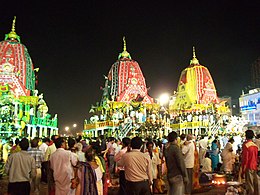
Grishma ( Sanskrit: ग्रीष्म, romanized: Grīṣhma) the Sanskrit word meaning summer. [1] This is one of the six seasons ( ritu), each lasting two months, the others being: Vasanta (spring), Varsha ( monsoon), Sharada ( autumn), Hemanta (pre- winter), and Shishira (winter). [2]
It falls in the two months of Jyeshtha and Ashadha of the Hindu calendar, or April and May of the Gregorian calendar. [3] It is preceded by Vasanta, the spring season, and followed by Varsha, the rainy season.
References
- ^ Barnett, Lionel D. (1999-04-30). Antiquities of India: An Account of the History and Culture of Ancient Hindustan. Atlantic Publishers & Dist. p. 189. ISBN 978-81-7156-442-2.
- ^ Klostermaier, Klaus K. (2010-03-10). A Survey of Hinduism: Third Edition. State University of New York Press. p. 492. ISBN 978-0-7914-8011-3.
- ^ Walker, Benjamin (2019-04-09). Hindu World: An Encyclopedic Survey of Hinduism. In Two Volumes. Volume I A-L. Routledge. p. 230. ISBN 978-0-429-62421-6.
Sources
- Selby, Martha Ann (translator). The Circle of Six Seasons, Penguin, New Delhi, 2003, ISBN 0-14-100772-9
- Raghavan, V. Ṛtu in Sanskrit literature, Shri Lal Bahadur Shastri Kendriya Sanskrit Vidyapeetha, Delhi, 1972.

Grishma ( Sanskrit: ग्रीष्म, romanized: Grīṣhma) the Sanskrit word meaning summer. [1] This is one of the six seasons ( ritu), each lasting two months, the others being: Vasanta (spring), Varsha ( monsoon), Sharada ( autumn), Hemanta (pre- winter), and Shishira (winter). [2]
It falls in the two months of Jyeshtha and Ashadha of the Hindu calendar, or April and May of the Gregorian calendar. [3] It is preceded by Vasanta, the spring season, and followed by Varsha, the rainy season.
References
- ^ Barnett, Lionel D. (1999-04-30). Antiquities of India: An Account of the History and Culture of Ancient Hindustan. Atlantic Publishers & Dist. p. 189. ISBN 978-81-7156-442-2.
- ^ Klostermaier, Klaus K. (2010-03-10). A Survey of Hinduism: Third Edition. State University of New York Press. p. 492. ISBN 978-0-7914-8011-3.
- ^ Walker, Benjamin (2019-04-09). Hindu World: An Encyclopedic Survey of Hinduism. In Two Volumes. Volume I A-L. Routledge. p. 230. ISBN 978-0-429-62421-6.
Sources
- Selby, Martha Ann (translator). The Circle of Six Seasons, Penguin, New Delhi, 2003, ISBN 0-14-100772-9
- Raghavan, V. Ṛtu in Sanskrit literature, Shri Lal Bahadur Shastri Kendriya Sanskrit Vidyapeetha, Delhi, 1972.